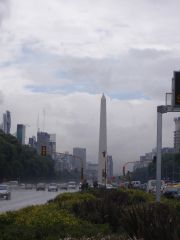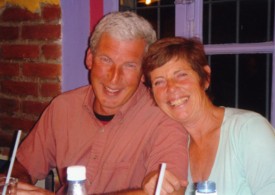South America- February to June 2006
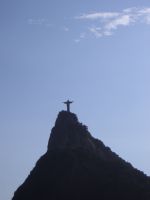 We started our South American adventure on Feb 24 when we flew to Rio in time for the Carnival.
We started our South American adventure on Feb 24 when we flew to Rio in time for the Carnival.
Rio was very busy with carnival taking over everything. After Rio we headed south to Parati which was a lovely old sea side town. We enjoyed a day on a yacht in very hot sunshine and Gerry was glad of the opportunity to snorkel. From there we visited the Villa Velha National Park and saw some amazing examples of how erosion can sculpt rocks. The first segment of our trip ended at Iguazu Falls which were truly amazing. A helicopter ride allowed us to appreciate the full majesty and extent of the Falls.
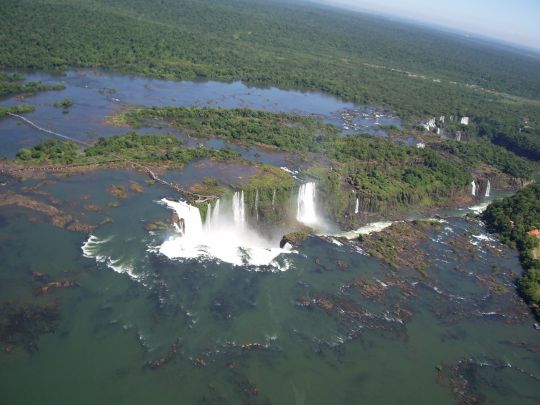 For the photos covering this section of the journey click here.
For the photos covering this section of the journey click here.
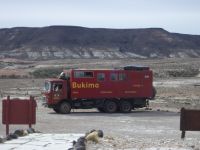 We crossed from Brazil into Argentina at Iguazu and after a look at the Falls from the Argentinian side we continued south in the big red truck that had already become our home from home.
We crossed from Brazil into Argentina at Iguazu and after a look at the Falls from the Argentinian side we continued south in the big red truck that had already become our home from home.
The journey was interesting with visits to the ruins of a Jesuit Mission and El Palmar National Park which is home to the threatened species of Yatay palm trees.
We reached Buenos Aires on 13 March and had a couple of days in the big city.
Here we suffered at the hands of a pickpocket who relieved Annie of her glasses and purse but it did mean an interesting day making police reports and phone calls to cancel credit cards etc. American Express replaced the travellers cheques stolen within 24 hours – truly fantastic service.
.
.
.
.
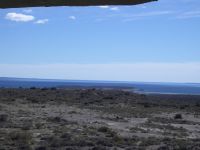 From Buenos Aires we travelled to the Valdez Peninsula and Puerto Madryn. The peninsula had a circular road in the middle of it that was only a few miles less in length than the M25 but only 34 permanent human residents. Our day on the peninsula was memorable for the many animals we saw some of which you can see in the photos covering this section of the journey (click here).
From Buenos Aires we travelled to the Valdez Peninsula and Puerto Madryn. The peninsula had a circular road in the middle of it that was only a few miles less in length than the M25 but only 34 permanent human residents. Our day on the peninsula was memorable for the many animals we saw some of which you can see in the photos covering this section of the journey (click here).
Puerto Madryn was a nice seaside town that allowed us an opportunity to relax and get up to date with laundry etc. We also travelled 50 Km up a track from the main road to visit a petrified forest and some amazing examples of old volcanos that had suffered from erosion to produce some very unnatural shaped hills.
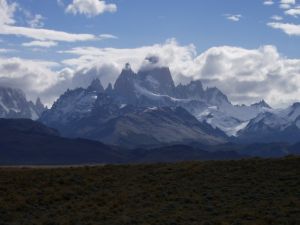 After leaving St Julian we reached the Patagonia we expected to see – vast open spaces with little in the way of people, buildings or vehicles and then magnificent mountain ranges covered with snow . The roads were unsealed but quite good (especially when compared to some that we travelled on later in the trip) We enjoyed the beauty of El Chalten and the nearby Fitzroy Glacier and then moved on to El Calafate and a visit to the Moreno Glacier. Wow is about the best word to describe all that we saw.
After leaving St Julian we reached the Patagonia we expected to see – vast open spaces with little in the way of people, buildings or vehicles and then magnificent mountain ranges covered with snow . The roads were unsealed but quite good (especially when compared to some that we travelled on later in the trip) We enjoyed the beauty of El Chalten and the nearby Fitzroy Glacier and then moved on to El Calafate and a visit to the Moreno Glacier. Wow is about the best word to describe all that we saw. 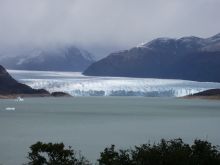
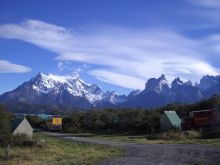
For the photos covering this section of the journey click here.
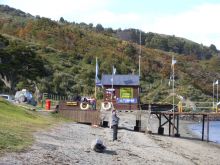 And so we reached the southernmost point on our trip on 1st April. Ushuaia was not quite as we expected being a very modern town that was clearly concentrating on tourism. Nevertheless we enjoyed walking around the town and a fairly long hike which included a visit to the most southerly post office in the world – a little shack on a beach! we also enjoyed a plane ride over the Beagle Channel that provided some awesome views and did make us realise just how bleak it could be during their winter.
And so we reached the southernmost point on our trip on 1st April. Ushuaia was not quite as we expected being a very modern town that was clearly concentrating on tourism. Nevertheless we enjoyed walking around the town and a fairly long hike which included a visit to the most southerly post office in the world – a little shack on a beach! we also enjoyed a plane ride over the Beagle Channel that provided some awesome views and did make us realise just how bleak it could be during their winter.
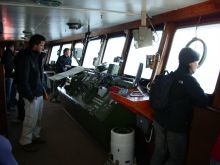 We then started to head northwards back to Puerto Natales where we caught a ferry for a 4 day cruise through the Chilean Fjords. The weather was far from perfect but we still had some lovely views and enjoyed being allowed on the Bridge of the ship at almost any time. We did see several whale spouts but our sighting of a whale was limited to a glimpse of a small portion of a whale’s back!
We then started to head northwards back to Puerto Natales where we caught a ferry for a 4 day cruise through the Chilean Fjords. The weather was far from perfect but we still had some lovely views and enjoyed being allowed on the Bridge of the ship at almost any time. We did see several whale spouts but our sighting of a whale was limited to a glimpse of a small portion of a whale’s back!
We left the ferry to head for Bariloche and a couple of days of good weather, fishing (unsuccessful) for Gerry, a day at a health spa for Annie, outstanding food and a trip to Cerro Otto where we drank champagne in a revolviing restaurant – decadent but enjoyable!!!!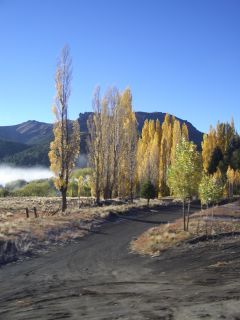
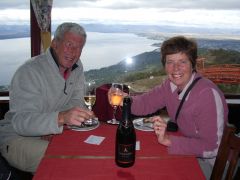
We next headed t0wards Pucon through some amazingly beautiful countryside with autumn colours beginning to take hold.
Click here for more photos of Ushuaia and our journey up to Pucon.
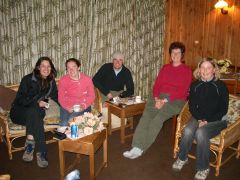
At Pucon 6 of us rented a bungalow for 3 days rather than camp. What a civilised weekend – we even threw a dinner party for the rest of the group and as it was Easter weekend, Annie made a lovely chocolate fudge cake decorated with Easter eggs. Pucon was a lovely town on the edge of a lake and not far from a smoking volcano. At night a red glow could be seen at the top of the volcano – An awesome first for us!
From Pucon we headed to Santiago. We are not lovers of big cities, but Santiago surprised us and we spent a couple of very enjoyable days exploring the sights and admiring the architecture. Leaving Santiago we travelled through some quite barren looking countryside and mountains to Mendoza.
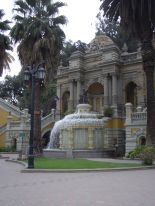
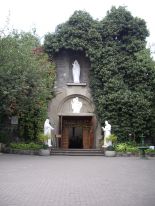
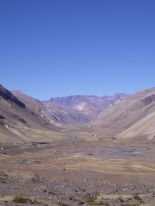
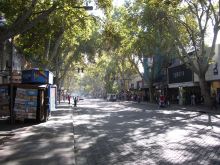
Mendoza was a lovely and peaceful town that was also close to some delightful wineries – What a great couple of days!!!!
But then we had to leave and head back into the desert.
The roads were often only just a little wider than the truck and the surface was usually very poor quality. Occasionally the road even disappeared! but we managed by going off road and digging ourselves out of trouble.
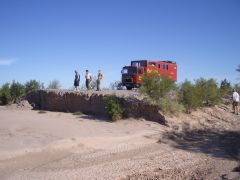
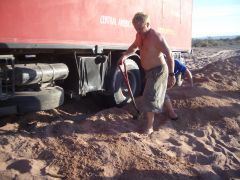
Click here for more photos of Pucon and our journey through Santiago, Mendoza and Cafayete to Salta
From Salta we headed across the border into Bolivia and even poorer quality roads. We also began to ascend but more of this later.
Our first stop was Tupiza and our introduction to the Bolivian traditional dress and culture.
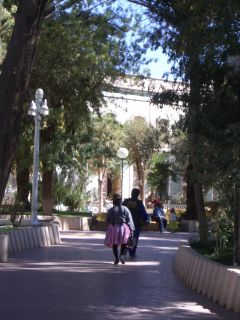
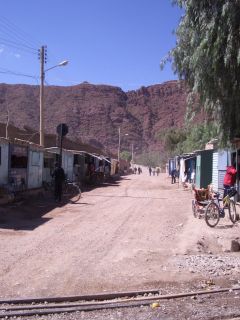
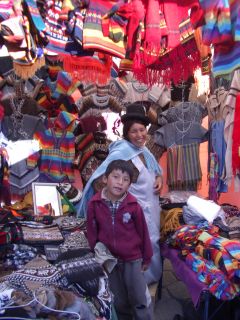
From Tupiza we headed to Uyuni and the salt flats (about 250Km by 270Km) and a vast expanse of white.
We visited Fish Island in the middle of the salt flats and as you can see it was like an island in a white sea.
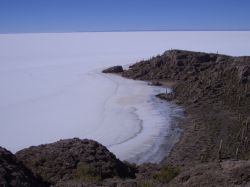
We continued to climb and spent a weekend at Potosi – the highest city in the World at 4070 metres above sea level. We found it quite difficult but at least we did not get altitude sickness. The highest we achieved was crossing a pass at just over 5000 metres (3 miles above sea level). We then dropped down to La Paz – a city of contrasts in the bowl of a volcano. We also visited Moon Valley just outside the city.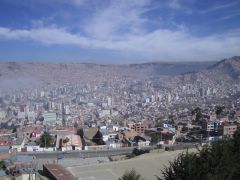
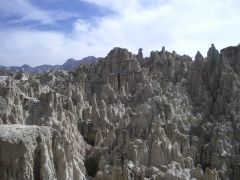
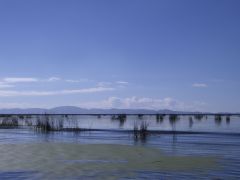 From La Paz we headed to Lake Titicaca and a visit to one o the floating islands before spending a night at a homestay on Amantani Island – no cars, no running water and no electric light in our home, cooking on a fire and it was very, very cold at night. Our host, Fortunata looked after us very well in deed and never stopped smiling!
From La Paz we headed to Lake Titicaca and a visit to one o the floating islands before spending a night at a homestay on Amantani Island – no cars, no running water and no electric light in our home, cooking on a fire and it was very, very cold at night. Our host, Fortunata looked after us very well in deed and never stopped smiling!
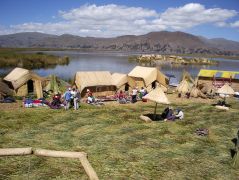
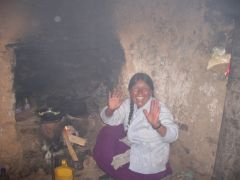
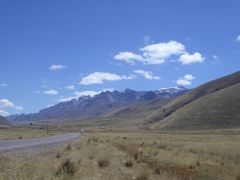 We then travelled on to Cusco through some really super countryside.
We then travelled on to Cusco through some really super countryside.
Click here for more photos of our journey through Bolivia
.
.
We made our base in Cusco for a week spending quite a bit of time in Cusco itself including visiting the sights and travelling up the Sacred Valley.
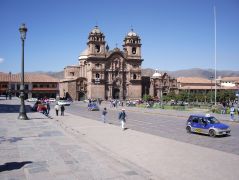
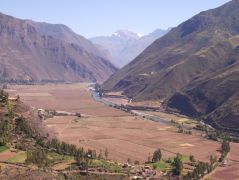
Although the Sacred Valley was beautiful countryside, it did not prepare us for the beauty of some of the Inca ruins such as those at Pisac shown below.
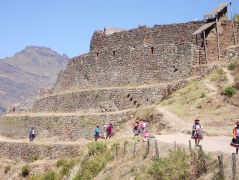
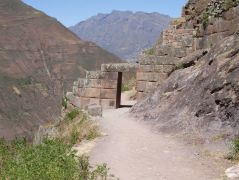
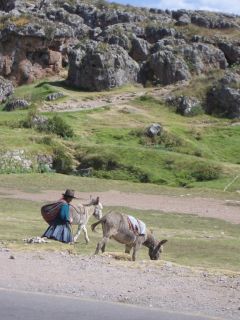 After a few days we caught a train to Agua Callientes for a night.
After a few days we caught a train to Agua Callientes for a night.
Again the scenery was beautiful en route and in the town itself, the railway ran through the main street – there were no vehicles apart from a couple of trucks, police car and the fleet of buses that took us to Machu Picchu itself.
.
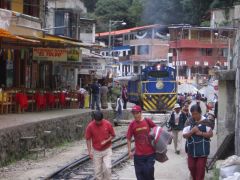
Machu Picchu at dawn is quite an awe inspiring sight. From our perspective it was a shame that there were so many tourists but if we thought it was crowded when we were there they were pouring in as we left! The real marvel of the site wa sits location on top of steepsided hills and the quality of the stone work.
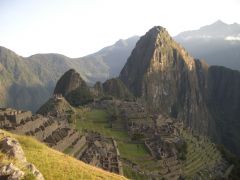
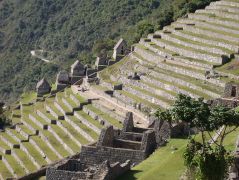
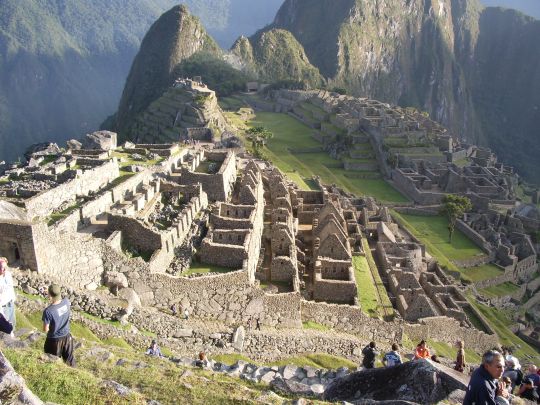
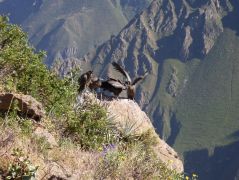 From Machu Picchu we headed back to Cusco by train and rejoined the truck for the last leg of our overlanding trip. The truck climbed to Colca Canyon, quite spectacular at 3900 metres deep (deeper than the Grand Canyon) for a dawn visit to see the Condors ascend out of the valley on the thermals created by the early morning sun.
From Machu Picchu we headed back to Cusco by train and rejoined the truck for the last leg of our overlanding trip. The truck climbed to Colca Canyon, quite spectacular at 3900 metres deep (deeper than the Grand Canyon) for a dawn visit to see the Condors ascend out of the valley on the thermals created by the early morning sun.
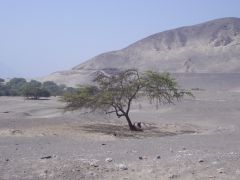
We continued to climb and crossed a pass at just over 5000 metres before dropping down to Arequippa and then on to the Peruvian desert for our last camp. The desert was generally bleak withthe odd beautiful sight. Our last camp was beside the sea and our truck got bogged down again. This time we could not dig it out and two of the group had to walk 7 km to a town to get help.
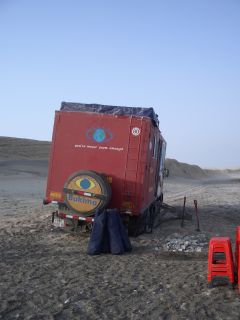
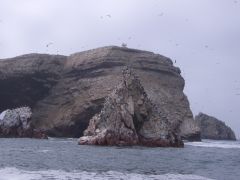
Our last day was spent visiting Ballasteros Islands where we saw more birds than we had ever seen in one location. We finally got to Lima and said our farewells to our fellow travellers most of whom had been with us for 3 months. Whilst some of the group had not fitted in and indeed had left the trip prematurely, the rest of us had become firm friends. We will miss them!
For the photos covering the final section of our overland journey click here.
From Lima we flew to Easter Island for two days enjoying this very remote island.(nearest land is the Pitcairn islands over 1200Km away nearest mainland is 2500Km away). The people and weather were great and the tour guide we had booked took us on two tours of the island. 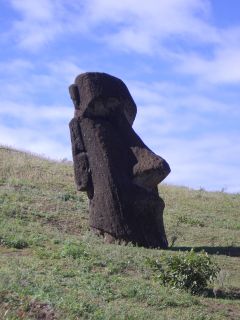
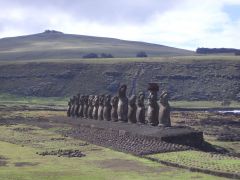
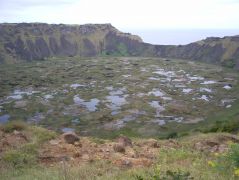 Rapa Nui were clearly the most spectaular sights but also looking down into the near circular resevoir inside an inactive volcano was also memorable. We left easter Island and headed for Los Angeles and an early return home as Annie’s mum sadly passed away. To see the photos of Easter Island click here.
Rapa Nui were clearly the most spectaular sights but also looking down into the near circular resevoir inside an inactive volcano was also memorable. We left easter Island and headed for Los Angeles and an early return home as Annie’s mum sadly passed away. To see the photos of Easter Island click here.

